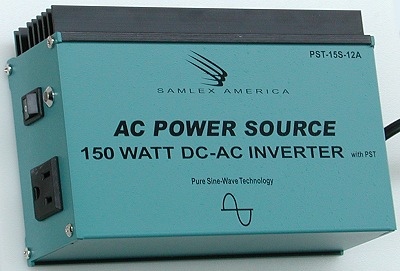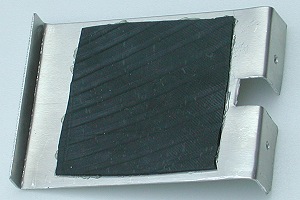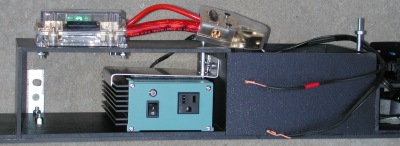Samlex PST-15S-12A Pure Sine Wave DC-AC Inverter
by Jeff Lucius
Introduction
Power inverters convert electrical direct current (DC) from a battery system into electrical alternating current (AC). The output AC waveform is either a pure sine wave or a modified sinewave, as illustrated below in a figure adapted from Wagan Corp. Less expensive power inverters usually produce a modified waveform, which can be sufficient for many devices, including televisions and VCRs, power tools, lights, and some personal computers. Pure sine-wave inverters are more expensive and produce current like that supplied by utility companies to your home or business. The clean, pure sine-wave current increases AC motor efficiency and life and reduces interference from electronic devices not connected to the inverter.

I used a 75W Jensen modified sine-wave inverter in my Stealth with my laptop computer without problems. When it was available, the Jensen inverter cost about $40 at Circuit City. However, I now wanted to install a nicer inverter in my battery shelf in the rear compartment. I chose the Samlex America PST-15S-12A, which accepts as input 10 to 15 volts DC and outputs 115 volts AC (pure sine wave) with a continuous output current of up to 150 watts and a surge power of 300 watts (for a few seconds). Inversion efficiency is about 90 percent. I would rather have used the 300 watt (500W surge) model (PST-30S-12A), except that the depth of the 15S matches the depth of my battery shelf, about 7.5". The 30S model is 11.22" deep (by 2.4" high by 4.7" wide and weighs about 3.5 lbs). The 15S model weighs about 2.5 lbs and is 2.4" high, 4.7" wide, and 7.4" deep.
This short note discusses how I installed this Samlex PST-15S-12A Power Inverter in the battery shelf of my Dodge Stealth. I purchased the PST-15S-12A from PerfectPower.Net in April 2003 for $116.42 plus $10 shipping. The "-12A" models are for the American market. The "-12E" models are for the European market.

Installation
The first thing I did was to identify which of the input wires is the positive one. The inverter can be damaged if connection polarity is reversed. The Samlex PST-15S-12A uses a male cigar lighter plug to connect to the car's electrical system. I wanted to connect the wires directly to my battery. The owner's manual identifies the center tip of the plug as positive (+) and the two spring-loaded clips on the sides as negative (-). Samlex provides their manuals online at http://www.samlexamerica.com/manualpdf.htm. I used a utility knife to separate the two wires a few inches from the plug. I cut one of the wires and wrapped a bit of tape on each loose wire. I then stripped the insulation back a little on the loose wire connected to the plug and checked to see if electrical continuity was to the tip or side clips (use the ohms setting on your volt ohm meter). I made a note of the result and finished cutting off the plug. I wrapped red electrical tape around the positive wire.
Next I made a bracket that holds the inverter securely in my battery shelf, yet allows me to easily slide the inverter out of the shelf if necessary. I used 1/16"-thick aluminum plate that I bent in a table vice and notched and drilled as needed. I glued a piece of truck tire inner tube to the underside of the bracket.

Below is a picture of the inverter installed in the battery shelf (out of the car). More information about this shelf is in my web page 2-battery-move.htm. The inverter power wires shown in front of the shelf were eventually connected directly to the EFX battery terminals. Because of this, the inverter is available when the ignition switch is off. However, the battery can drain quickly when a load is applied to the inverter and the engine is not running. Even without a load, the inverter's idle power draw is about 0.5 amps, which will slowly drain the battery if the inverter is left on. DonRow.com provides power usage chart for common appliances and tools. Check the power requirements of the device(s) you plug into the inverter (usually stamped into the device or on a label) and be sure the total load (that is, the total power or watts) does not exceed the rated continuous power output of the inverter.

Page last updated May 26, 2003.




